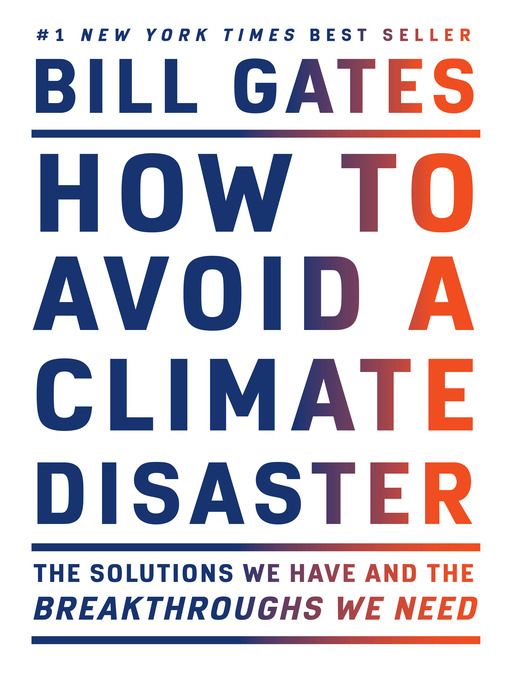
How to Avoid a Climate Disaster
The Solutions We Have and the Breakthroughs We Need
- اطلاعات
- نقد و بررسی
- دیدگاه کاربران
نقد و بررسی

January 1, 2020
Microsoft cofounder Gates argues that climate change will have the biggest impact on those who have done the least to cause it, and he's spent a decade studying its consequences and considering how best to address them. Here he promotes new carbon-zero technologies that can be deployed quickly worldwide, aiming for zero greenhouse gas emissions.
Copyright 2020 Library Journal, LLC Used with permission.

December 14, 2020
Gates (The Road Ahead), Microsoft cofounder turned philanthropist, is optimistic in this cogent guide to avoiding “the worst effects of climate change.” Gates’s goal is to get from the 51 billion tons of greenhouse gasses added to the atmosphere annually to zero. This is possible, he writes, by making use of existing technologies and developing new ones to remove emissions: transportation’s “zero-carbon future,” for example, will mean using “electricity to run all the vehicles we can, and getting cheap alternative fuels for the rest.” (Such alternatives include electrofuels, which, he notes, researchers are developing.) Gates rounds out his advice with steps for governments and individuals: he encourages citizens to “make calls, write letters, attend town halls,” while Congress should financially incentivize green policies, and state governments can “test policies like carbon pricing” before they’re implemented countrywide. Readers will enjoy Gates’s sometimes breezy tone (“You have to be a pretty big nerd to write a sentence like ‘I’m in awe of physical infrastructure’ ”), and while his scientific solutions are never fringe, not all of his ideas strike as politically feasible. Nonetheless, those looking for an accessible review of how global warming can be countered will find this a handy—and maybe even hope-inspiring—guide.

January 1, 2021
A persuasive, optimistic strategy for reducing greenhouse emissions to zero by midcentury. In his latest book, Gates makes a significant contribution to the rapidly growing shelf of books that not only acknowledge climate change, but also propose viable solutions; other examples include Eric Holthaus' The Future Earth and David Attenborough's A Life on Our Planet. Gates moves several steps further in a comprehensible, at times amusingly wonky, text that provides detailed plans. The author relates a compelling vision of what the potential devastation will look like, assessing the scale and range of expected damage, but he is more interested in clearly communicating the multitiered facets of his plan. While drawing on his expertise and instincts as a successful tech innovator, investor, and philanthropist, Gates relies on teams of experts in science, engineering, and public policy to flesh out the details. The author focuses on five major emissions-generating activities--making things, plugging in, growing things, getting around, and keeping cool and warm--and he breaks down his global plan to address the level of a given country's financial capabilities. Gates applies his 2050 goal to developed, relatively wealthy countries, with others following as soon as possible after that date. Though we already have some of the tools necessary to implement his plan, many of them are not used widely enough, and Gates presses for increased investment in well-guided research and development and innovation in the efficiency of our electricity use. "We need to accomplish something gigantic we have never done before," writes the author, "much faster than we have ever done anything similar," which will require building "a consensus that doesn't exist" and policy that will "push a transition that would not happen otherwise." Though Gates doesn't shy away from acknowledging the daunting challenges ahead, his narrative contains enough confidence--and hard science and economics--to convince many readers that his blueprint is one of the most viable yet. A supremely authoritative and accessible plan for how we can avoid a climate catastrophe.
COPYRIGHT(2021) Kirkus Reviews, ALL RIGHTS RESERVED.

January 1, 2021
In many respects, it can be argued that philanthropist and business leader Gates' title is moot since the planet is already in the midst of a climate disaster. The strength of his argument for meaningful environmental action lies in the subtitle because solutions for mitigating this crisis do exist, and the innovative thinking required for implementing is an accessible resource. Doing nothing, Gates posits, is not an option, while doing almost anything to positively impact climate change is difficult but not impossible. From manufacturing to farming, transportation to consumer practices, every aspect of life is affected by and exerts an effect on climate change. How governments and individuals respond to this planetary challenge has long fascinated Gates, a self-described policy wonk and techno geek who has put his considerable wealth behind global health, educational, and economic initiatives and now turns his laser-like attention to this most existential of issues. While Gates' positions and evidence can skew toward the intellectual at often granular levels, he nevertheless provides illuminating contexts for those perspectives and offers a treatise that is imperative, approachable, and useful.HIGH-DEMAND BACKSTORY: Gates will be all over the media doing interviews about this clarion work as renewed attention is paid to this urgent issue.
COPYRIGHT(2021) Booklist, ALL RIGHTS RESERVED.




دیدگاه کاربران